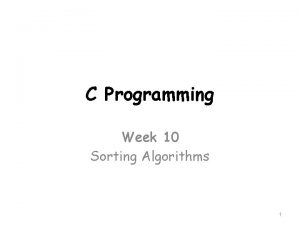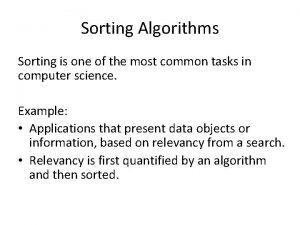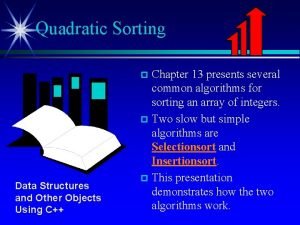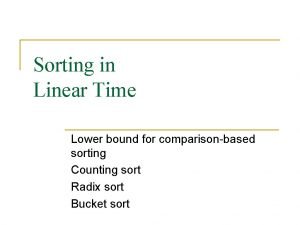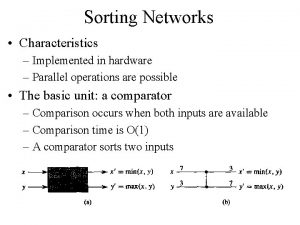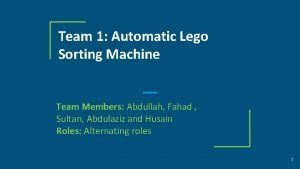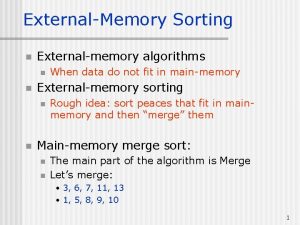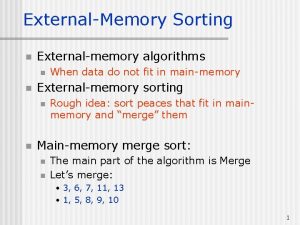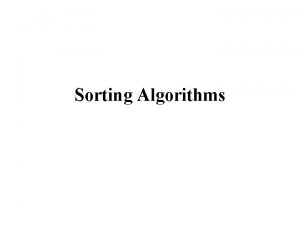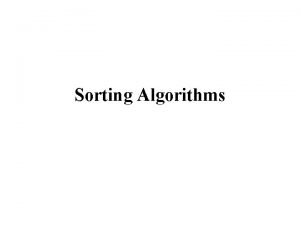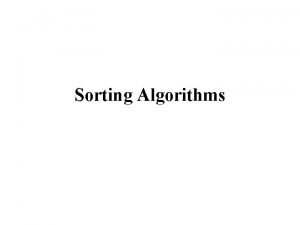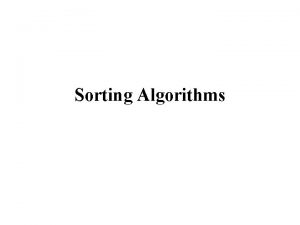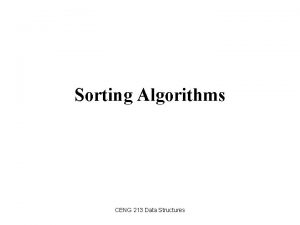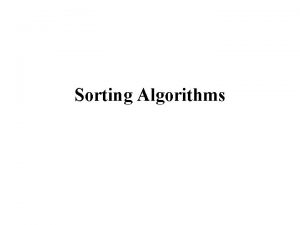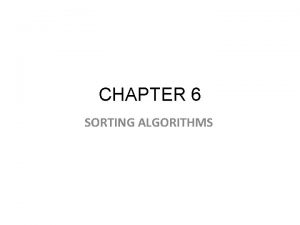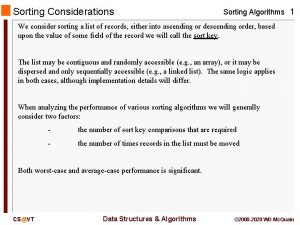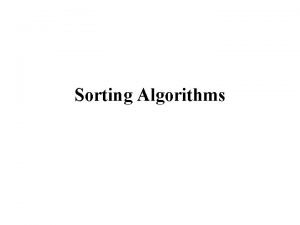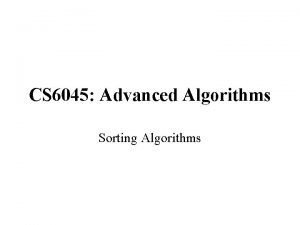ExternalMemory Sorting n Externalmemory algorithms n n Externalmemory















- Slides: 15

External-Memory Sorting n External-memory algorithms n n External-memory sorting n n When data do not fit in main-memory Rough idea: sort peaces that fit in mainmemory and “merge” them Main-memory merge sort: n n The main part of the algorithm is Merge Let’s merge: • 3, 6, 7, 11, 13 • 1, 5, 8, 9, 10 1

Main-Memory Merge Sort Merge-Sort(A) 01 if length(A) > 1 then 02 Copy the first half of A into array A 1 03 Copy the second half of A into array A 2 04 Merge-Sort(A 1) 05 Merge-Sort(A 2) 06 Merge(A, A 1, A 2) n Divide Conquer Combine Running time? 2

Merge-Sort Recursion Tree log 2 N 1 2 3 4 5 6 1 2 5 7 9 10 13 19 3 1 2 5 10 9 13 19 3 2 10 10 n n 2 7 7 1 5 13 19 5 1 13 19 8 9 7 9 9 7 10 11 12 13 15 17 19 4 6 8 11 12 15 17 4 8 15 6 11 12 17 4 15 15 4 3 8 12 17 8 3 12 17 6 11 In each level: merge runs (sorted sequences) of size x into runs of size 2 x, decrease the number of runs twofold. What would it mean to run this on a file in external memory? 3

External-Memory Merge-Sort n Idea: increase the size of initial runs! n Initial runs – the size of available main memory (M data elements) 1 2 3 4 5 6 7 8 9 10 13 19 3 9 13 19 3 11 12 13 15 17 19 4 6 8 11 12 15 17 4 8 15 6 11 12 17 External two-way merge 1 2 5 7 External two-way merges 1 2 5 10 Main-memory sort 10 2 5 1 7 Main-memory sort 13 19 9 7 Main-memory sort 15 4 8 3 Main-memory sort 12 17 6 11 4

External-Memory Merge Sort n n Input file X, empty file Y Phase 1: Repeat until end of file X: n n Read the next M elements from X Sort them in main-memory Write them at the end of file Y Phase 2: Repeat while there is more than one run in Y: n n n Empty X Merge. All. Runs(Y, X) X is now called Y, Y is now called X 5

External-Memory Merging n Merge. All. Runs(Y, X): repeat until the end of Y: n n Call Twoway. Merge to merge the next two runs from Y into one run, which is written at the end of X Twoway. Merge: uses three main-memory arrays of size B Read, when p 1 = B (p 2 = B) Bf 1 min(Bf 1[p 1], Bf 2[p 2]) p 1 po Bf 2 p 2 Current page Bfo Current page Write, when Bfo full File Y: EOF Run 1 Run 2 File X: Merged run 6

Analysis: Assumptions n Assumptions and notation: n Disk page size: • B data elements n Data file size: • N elements, n = N/B disk pages n Available main memory: • M elements, m = M/B pages 7

Analysis 8 M = N Phase 2 4 M 4 M 2 M Phase 1 n 2 M 2 M M M M M Phase 1: n n 2 M Read file X, write file Y: 2 n = O(n) I/Os Phase 2: n n One iteration: Read file Y, write file X: 2 n = O(n) I/Os Number of iterations: log 2 N/M = log 2 n/m 8

Analysis: Conclusions n Total running time of external-memory merge sort: O(n log 2 n/m) n We can do better! n Observation: n n Phase 1 uses all available memory Phase 2 uses just 3 pages out of m available!!! 9

Two-Phase, Multiway Merge Sort n Idea: merge all runs at once! n n Phase 1: the same (do internal sorts) Phase 2: perform Multiway. Merge(Y, X) 8 M = N Phase 2 Phase 1 M M M M 10

Multiway Merging Bf 1 p 1 Bf 2 Read, when pi = B p 2 min(Bf 1[p 1], Bf 2[p 2], …, Bfk[pk]) Bfo po Bfk pk Current page Write, when Bfo full Current page File Y: Run 1 Run 2 Run k=n/m EOF File X: Merged run 11

Analysis of TPMMS n Phase 1: O(n), Phase 2: O(n) n Total: O(n) I/Os! n The catch: files only of “limited” size can be sorted n Phase 2 can merge a maximum of m-1 runs. n Which means: N/M < m-1 n How large files can we sort with TPMMS on a machine with 128 Mb main memory and disk page size of 16 Kb? 12

General Multiway Merge Sort n What if a file is very large or memory is small? n General multiway merge sort: n Phase 1: the same (do internal sorts) n Phase 2: do as many iterations of merging as necessary until only one run remains Each iteration repeatedly calls Multiway. Merge(Y, X) to merge groups of m-1 runs until the end of file Y is reached. 13

Analysis (m-1)3 M = N Phase 2 (m-1)M Phase 1 n n . . . (m-1)M M M … M . . . M M … M Phase 1: O(n), each iteration of phase 2: O(n) How many iterations are there in phase 2? n n . . . (m-1)2 M Number of iterations: logm-1 N/M = logmn Total running time: O(n logm n) I/Os 14

Conclusions n External sorting can be done in O(n logm n) I/O operations for any n n n This is asymptotically optimal In practice, we can usually sort in O(n) I/Os n Use two-phase, multiway merge-sort 15
 Internal vs external sorting
Internal vs external sorting Sorting algorithms in c
Sorting algorithms in c N
N Clhelse
Clhelse Algorithm efficiency
Algorithm efficiency Most common sorting algorithms
Most common sorting algorithms Quadratic sorting algorithms
Quadratic sorting algorithms Place:sort=8&redirectsmode=2&maxresults=10/
Place:sort=8&redirectsmode=2&maxresults=10/ Introduction to sorting algorithms
Introduction to sorting algorithms Efficiency of sorting algorithms
Efficiency of sorting algorithms Bsort
Bsort Lower bound for comparison based sorting algorithms
Lower bound for comparison based sorting algorithms Searching and sorting arrays in c++
Searching and sorting arrays in c++ Sorting network
Sorting network Selection sort vs bubble sort
Selection sort vs bubble sort Lego sorting machine
Lego sorting machine

